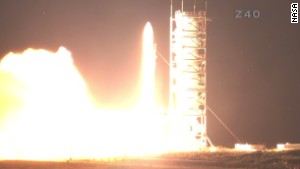- Back to Home »
- Frog photobombs NASA launch
- Frog caught in launch of moon mission
- NASA confirms photo is no fake
- Frog likely caught in pool under launchpad
(CNN) -- Frogggsss in spaaaccceee!
Or frog, at least. And maybe not in space, but for certain a wild ride.
Look closely at the photo above and you'll see the little guy streaking skyward alongside a 90-foot-tall rocket carrying a moon mission from the Mid-Atlantic Regional Spaceport at NASA's Wallops Flight Facility in Virginia on Friday.
Another piece of science fiction, you're thinking.
But NASA confirms the photo, taken by a remote camera during Friday's launch of the Lunar Atmosphere and Dust Environment Explorer (LADEE), is not some trick.
 NASA launches unmanned moon orbiter
NASA launches unmanned moon orbiter "The photo team confirms the frog is real and was captured in a single frame by one of the remote cameras used to photograph the launch," it says on its website.
The photo was first posted online Wednesday by Universe Today.
It's been hopping around the internet since.
And prompting some super puns we have to share.
"This frog gives new meaning to "flying leap," (or giant leap)." Universe Today in that original post.
"From lily pad to launch pad." The Independent.
"An unlucky frog took a giant leap for mankind." News.com.au
"Did it croak?" NBC News
And not to be outdone, a source told CNN the creature's last words were: "Orrrbit, orrrbit."
"The condition of the frog, however, is uncertain," NASA says on its website, but these kind of things tend not to end well for amphibians.
So how did it get there in the first place?
"The launchpad at the Wallops/Mid-Atlantic Regional Spaceport has a 'pool' for the high-volume water deluge system that activates during launches to protect the pad from damage and for noise suppression, and likely there was a (formerly) damp, cool place that was a nice spot for a frog to hang out," Universe Today reported.
While the frog's short trip to the final frontier may be over, LADEE's continues. It is expected to reach lunar orbit on October 6 and then commence gathering "detailed information about the lunar atmosphere, conditions near the surface and environmental influences on lunar dust," NASA said. "A thorough understanding of these characteristics will address long-standing unknowns, and help scientists understand other planetary bodies as well."







